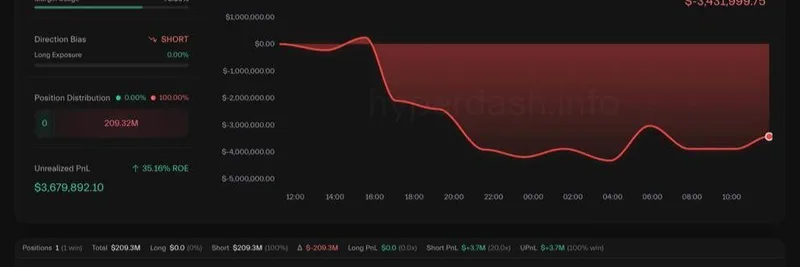In the fast-paced world of crypto, where fortunes can flip in a flash, whales—those big players with massive holdings—often steal the show. A recent tweet from @StarPlatinumSOL has the community buzzing about what he calls "the most dangerous address in crypto right now": 0xb317d2bc2d3d2df5fa441b5bae0ab9d8b07283ae. Let's break down what's going on with this mysterious wallet and why it's got everyone on edge.
The Whale's Bold Moves on Hyperliquid
Hyperliquid is a decentralized exchange (DEX) specializing in perpetual futures, or "perps," which let traders bet on asset prices with leverage without an expiration date. Leverage means borrowing funds to amplify your position—for example, 10x leverage turns $1 into $10 worth of exposure, but it also magnifies losses.
Back on October 13, this address deposited a whopping $40 million in USDC (a stablecoin pegged to the US dollar) straight into Hyperliquid. Just minutes later, it opened a massive $343.6 million short position on Bitcoin (BTC), equivalent to about 3,000 BTC at 10x leverage. A short position bets on the price dropping; if it does, you profit big.
This built on shorts started three days earlier, and the timing couldn't have been more spot-on. During the October 10 market crash—triggered right after a Trump tariff announcement—the whale pocketed an eye-watering $192 million in profits. The precision has folks whispering about possible insider info, though nothing's proven.
After cashing in, the whale closed most of those shorts and withdrew $60-80 million in USDC profits. But they weren't done.
Switching Gears: From Shorts to Longs
Fast forward to November 3, and the wallet bridged in another $20 million USDC. This time, it flipped the script, going long on both BTC and ETH. A long position bets on the price rising.
Current open positions include:
- 600 BTC long at 5x leverage, entered around $63,500
- 13,000 ETH long at 5x leverage, entered around $3,650
That's about $104 million in total exposure, with equity (the account's net value) at roughly $39.4 million. Right now, they're sitting on a -7.7% PnL (profit and loss), down about $3.03 million, plus daily funding fees of -$18K. Funding fees are payments between long and short traders to keep the perp price aligned with the spot price.
The pattern is clear and consistent:
- Huge USDC deposits
- Shorts timed just before big events
- Scaling up during dips
- Profits pulled back to Layer 1 (main blockchain like Ethereum)
- Quiet buildup for the next move
For now, the whale is holding steady on these longs. Liquidation—where the position gets force-closed if losses eat too much margin—kicks in if BTC drops below $42K or ETH nears $560. But with $39 million in equity, there's plenty of buffer.
Ties to Meme Tokens?
Interestingly, amid all this high-stakes trading, the address has dabbled in meme tokens. A recent transfer sent 696,969 PEEZY tokens (worth about $1.3 at the time) to another wallet. Meme tokens like PEEZY are volatile, community-driven coins often inspired by internet culture. While this is a tiny blip compared to the millions in play, it shows the whale isn't above dipping into the fun, speculative side of crypto. For meme enthusiasts, tracking whales like this can signal broader market shifts that ripple into smaller tokens.
Why This Matters for Crypto Traders
This whale's actions highlight the power of on-chain analysis—tracking wallet movements publicly on the blockchain. Tools like Etherscan or Arkham Intelligence make it possible for anyone to spot these patterns. But it also raises questions about market fairness: Is this just savvy trading, or something more?
If you're into meme tokens or broader blockchain plays, keeping an eye on big movers like this can give you an edge. Whales often lead the way, and their shifts could impact everything from BTC dominance to altcoin pumps.
Stay tuned—crypto never sleeps, and neither do its whales. If you've spotted similar patterns, drop a comment below!

